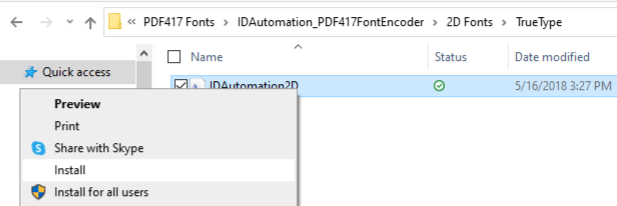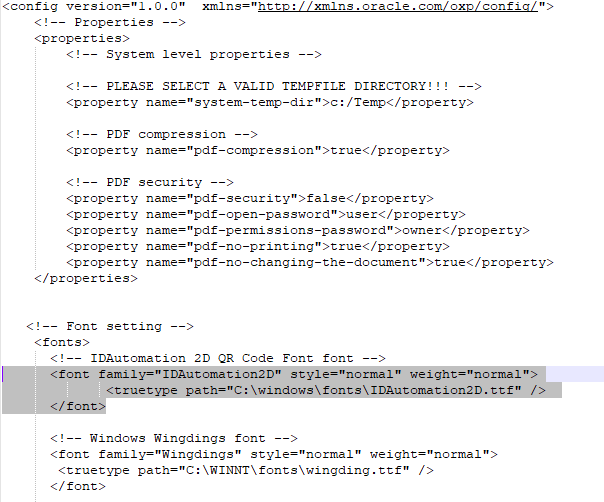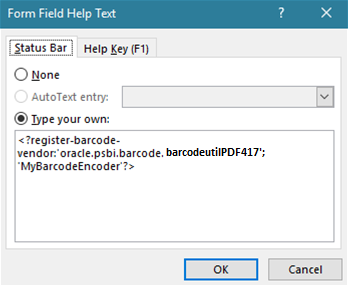 Ben
Ben
Best Answer
This IDAutomation user guide explains how to produce barcodes in BI Publisher for Oracle developers who use E-Business Suite. Only developers with BIP report design, XML, and Java experience must perform the solution. Only developers with BIP report design, XML, and Java barcode encoder experience must perform the solution. IDAutomation only supports the Java barcode encoder available through our company. To troubleshoot barcode generation issues in BIP, ensure the Java barcode encoder performs in a stand-alone application (an example is included in the product). If the Java barcode encoder performs in a stand-alone application but does not function in BIP, contact Oracle Support for more information.
The Java barcode encoder so
-INSTALL FONTS-
1. Install all BI Publisher requirements (BI Publisher, Microsoft Word).
2. Purchase, download, and extract the PDF417 Font Encoder Package zip file.
3. To install the IDAutomation2D font, run the .exe file located in the package or manually install the font located by searching for *.ttf. Once the file(s) is located, right-click and choose Install.

-SET UP JAVA CLASS-
4. Download and install the PDF417 Developer Tools from the IDAutomation store and extract the IDAutomation_PDF417_Developer_Tools.zip.
5. Locate the IDAutomation_JavaFontEncoder_PDF417.jar and extract this file to use the com-idautomation-fontencoder-pdf417-PDF417Encoder.class and set up the jar file in your Java environment.
NOTE: Prior to implementing the solution in BI Publisher, confirm that you can create a PDF417 barcode in a stand-alone application/project. If not, ensure that the PDF417 class file is part of the classpath within your Environment Variables.
-CREATE BARCODEUTIL.CLASS-
6. Download the IDAutomation_BIPublisher_PDF417.zip. It includes the barcodeutilPDF417.java and dependencies (Logger.class and XDOBarcodeEncoder.class) for creating the barcodeutilPDF417.class.

7. Open the barcodeutilPDF417.java file. The Encoder section of the tutorial provides an example of the parameters. Update the parameters in the .java file based on the barcode requirements:
/* Import the idautomation encoder class */
import com.idautomation.fontencoder.pdf417.*;
PDF417Encoder pdfe = new PDF417Encoder();
return pdfe.fontEncode(DataToEncode);
Class[] clazz = new Class[] { "".getClass() };
ENCODERS.put("pdf417" , mUtility.getClass().getMethod("pdf417" , clazz));
8. Compile the barcodeutilPDF417.java file to create the barcodeutilPDF417.class.
-SET UP JAR FILES-
9. Access the jlib path and reference the listed JAR files in the classpath:

- xdocore.jar
- xmlparserv2.jar
- collections.jar
- aolj.jar
- share.jar
- xdoparser.jar
- jewt4.jar
- 18nAPI_v3.jar
10. Place the barcodeutilPDF417.class into the barcodejar.jar.
11. Copy the IDAutomation_PDF417_JavaFontEncoder.jar and the barcodejar.jar to the jlib folder within the Template Builder for Word.
12. Place the JARs into the RTF2PDF.jar, located in the jlib folder. In newer versions of BI Publisher, the JAR is named RTF2PDFv2.jar, it functions the same.
13. Make a backup of the RTF2PDF.jar file.
14. Open the RTF2PDF.jar using Winzip or 7-zip and access the META-INF directory. Open and edit the MANIFEST.MF to include the jars at the end of the classpath list:
Manifest-Version: 1.0
Class-Path: ./activation.jar ./mail.jar ./xdochartstyles.jar ./bicmn.jar ./jewt4.jar
./share.jar ./bipres.jar ./xdoparser.jar ./xdocore.jar ./xmlparserv2.jar
./xmlparserv2-904.jar ./i18nAPI_v3.jar ./versioninfo.jar
./barcodejar.jar ./PDF417Encoder.class
Main-Class: RTF2PDF
-SET UP TO RENDER BARCODE-
15. To render the barcode in a PDF report, reference the font within a config file in the BI Publisher config folder. Open the xdo example.cfg file located:

16. Add an entry for the IDAutomation2D font in the code area under the font setting:

-WORD SET UP-
17. In Word, access the BI Publisher file. Double-click the field to the barcode and choose Add Help Text to open the Form Field.
18. In the Status Bar tab, enter the first command:
<?register-barcode-vendor:'ENCODER WRAPPER CLASS'; 'ENCODER NAME'?>

19. In the Help Key (F1), enter the second command:
<?format-barcode:DATA_TO_ENCODE;'ENCODER_METHOD_NAME';'ENCODER_NAME'?>
<?format-barcode:AS_OF_DATE;pdfe';'MyBarcodeEncoder'?>
20. To ensure the data is encoded, view the document (PDF, RTF, HTML):
The PDF417 displays as a collection of numbers.
21. Return to the project and select the IDAutomation2D font from the font list. IDAutomation2D is the appropriate font for PDF417.
 Posted 4.5 year(s) ago Posted 4.5 year(s) ago
|

 Email this question link to friends
Email this question link to friends  My Profile
My Profile